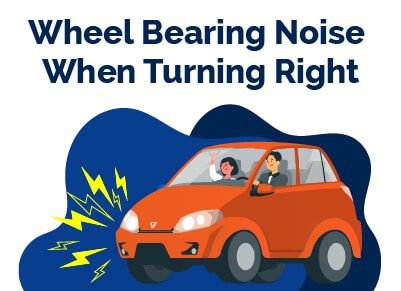Why Your Wheel Bearing Makes Noise When Turning Right
April 5, 2023


I am a serial entrepreneur and a consumer advocate. When I’m not helping car buyers, I love working on ventures that have a positive impact.
I run a cause marketing agency and serve on the board of Vayu Global Health where we are disrupting the medical industry and preventing the needless deaths of mothers and babies during childbirth.
So, you’re driving down the road, and you notice a strange noise when you turn right, does this sound familiar?
The angle or direction where your wheel bearing noise comes from indicates which side of the wheel bearing is bad. When turning right, the wheel bearing noise indicates that you have a bad left wheel bearing.
When a wheel bearing is bad, your car will start making noise when loads are thrown in its direction. This means that each turn you make throws your car’s weight in the opposite direction. The noise increases when the weight is thrown in the direction of the bad wheel bearing.
Table of Contents
Why Your Car Makes Noise When Turning Right Video
Wheel Bearing Noise When Turning Right
A worn wheel bearing on the left can cause a wheel bearing noise when turning right.
A wheel bearing noise when turning right shows that your left wheel bearing is bad or gradually failing. This is because when you turn your car to the right, the overall weight of the car and its occupants is thrown to the left wheels and suspension.
With the opposite direction bearing the car’s weight, the car will make noise when you turn in one direction if you have a bad wheel bearing.
However, most drivers believe this does not work in all cases. The noise diagnostic test doesn’t give you 100% assurance on which side of your wheel bearing is bad, and it doesn’t work the same in all cars.
For instance, in Volkswagen Mark IVs, the wheel bearing noise test doesn’t work as expected. These cars have double-row angular contact bearings. There are double sets of ball bearings in the physical bearing shell of the vehicle; this gives you an inner and outer bearing set.
In this case, one set of the bearing might be bad, and even though it makes noise when you turn right, you might make the mistake of changing the whole set.
Moreover, when turning right, the wheel bearing noise shows that the left wheel bearing is bad, but you shouldn’t rely on this a lot to decide if the damage is on the passenger side bearing or driver side bearing.
A lot of people have ended up making a lot of mistakes using the “swerve test” to decide the exact wheel bearing that is bad.
Will the Noise Stop When You Turn Right?
It depends!
For the wheel bearing noise to go away when you turn right, you need to have a good left wheel bearing.
When you turn right, the wheel-bearing noise goes away because your vehicle's weight moves from the right wheels/position to the left. In this situation, the noise will remain if you have a bad wheel bearing.
You should notice some noise in your car when driving straight if you have a bad right wheel bearing. Turning right will unload the pressure on the right wheel bearings, making the noise go away for a little while. You can use this technique to decide which side of your wheel bearing is bad.
How Do You Tell if The Right or Left Wheel Bearing Is Bad?
To tell which wheel bearing is making noise, you must run a series of tests on the car.
Here are some simple ways to tell if the right or left wheel bearing is bad.
1. Take your car for a ride
Taking your car for a test drive might not help you decide which side of the wheel bearing is bad, but it will give you some convictions that you have a bad wheel bearing. During the car test, you should look for growling or howling noise from your car.
2. Jack up the wheels
Get a heavy-duty hydraulic jack, or a car lift, whichever your hands can afford. Suspend the wheels in the air, ensuring that all wheels hang equally above the ground.
3. Spin the wheels
In suspension, you can decide to turn on your car’s engine and rev until the tires are running on average speed. This is quite risky, and you don’t need to do it if you are scared. A safer way is to use your hands to spin each tire individually as fast as possible.
It would be best if you looked for any strange sounds in any of the wheels and checked out for plays and roughness. Inspect the right and left wheels to decide which ones have a bad wheel bearing.
You can hold both tires with both hands in the opposite directions and shake them. You have a bad wheel bearing if the wheels wobble or make a weird noise when you spin.
Summary
You must limit your wheel bearing diagnostics to only noise and swerve tests. You might not make factual decisions. Bad wheel bearing, CV joints, and brakes have similar sounds.
You might find it difficult to differentiate between the grinding sound of a bad brake and the growling sound of a bad wheel bearing. It becomes highly advisable that you book an appointment with a trusted auto mechanic near you.
Best Car Deals by Category
Frequently Asked Questions
Can a wheel bearing only make noise when turning?
No. Wheel bearings do not only make noise when you are turning. The noise only becomes louder if you are turning in the direction of a bad wheel bearing. This is because of a shift in weight on your car’s suspension.
What does a wheel bearing sound like when it’s going out?
A wheel bearing that is going out makes a growling and howling sound. Sometimes, the sounds may include a humming or clicking noise. These sounds will increase when you make a turn in one direction or when you accelerate.
Can both wheel bearings go bad at the same time?
Yes. Both wheel bearings can go bad at the same time. Both wheel bearings can also go bad if enough grease wasn’t applied to them during the replacement of the brake rotors or the spindle nuts were over-tightened.
Posted in Car Buying Tips, Car Troubleshooting |





